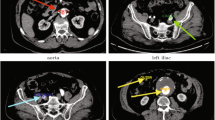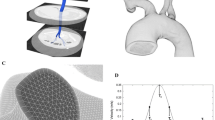Abstract
The purpose of this study is to characterize the evolution of the hemodynamic forces acting on the arterial walls at progressive stages of enlargement of abdominal aortic aneurysms (AAA). The specific aims are twofold: first, to determine the magnitude of the “wall shear stresses” (WSS) and their spatial and temporal gradients at various stages of enlargement, and second, to identify the critical size at which the formation of regions of stasis and/or the transition to a turbulent state occur inside the AAA. A parametric in vitro study of the pulsatile blood flow was conducted in rigid models of AAA by systematically varying the hemodynamic conditions and the size of the aneurysm. The instantaneous flow characteristics inside the AAA models were measured along the cardiac cycle, using tomographic digital particle image velocimetry (TDPIV). The TDPIV measurements showed that even for the case of large dilatation ratios (internal diameter >4.5 mm), the flow inside the AAA remained fully attached to the walls during systole, but massively detached during diastole. A critical aneurysm aspect ratio (length-to-diameter ratio) was found, for which a transition to a turbulent state occurred. The formation of internal shear layers (internal jet) and slowly recirculating regions (stasis) generated large spatial gradients of WSS and regions of low and oscillating WSS. The formation of regions of flow stasis was observed even at very early stages in the aneurysm enlargement. These spatial and temporal variations in the hemodynamic forces, the formation of regions of stasis, and the transition to turbulence are postulated to play an important role in the etiology of the disease by activating endoluminar thrombus formation, lipid deposition, and certain inflammatory mechanisms.




Similar content being viewed by others
References
A Verloes N Sakalihasan R Limet (1996) Genetic aspects of abdominal aortic aneurysm. MD Tilson CD Boyd (Eds) The Abdominal Aortic Aneurysm: Genetics, Pathophysiology, and Molecular Biology Academy of Sciences New York 44–55
H Bengtsson B Sonesson D Bergqvist (1996) Incidence and prevalence of abdominal aortic aneurysms, estimated by necropsy studies and population screening by ultrasound. MD Tilson CD Boyd (Eds) The Abdominal Aortic Aneurysm: Genetics, Pathophysiology, and Molecular Biology Academy of Sciences New York 1–24
JL Cronenwett (1996) Variables that affect the expansion rate and rupture of abdominal aortic aneurysms. MD Tilson CD Boyd (Eds) The Abdominal Aortic Aneurysm: Genetics, Pathophysiology, and Molecular Biology Academy of Sciences New York 56–67
ABM Wilmink CRG Quick CSF Hubbard et al. (2000) ArticleTitleThe association between connective tissue laxity and the risk of an abdominal aortic aneurysm. Eur J Vasc Endovasc Surg 20 290–295 Occurrence Handle1:STN:280:DC%2BD3M%2FhtVSnuw%3D%3D Occurrence Handle10986029
InstitutionalAuthorName. (2000) ArticleTitleSmoking, lung function and the prognosis of abdominal aortic aneurysm. The UK Small Aneurysm Trial Participants. Eur J Vasc Endovasc Surg 19 636–642
D Bluestein L Niu RT Schoephoerster et al. (1996) ArticleTitleSteady flow in an aneurysm model: correlation between fluid dynamics and blood platelet deposition. J Biomech Eng 118 280–286 Occurrence Handle1:STN:280:ByiD38ngs10%3D Occurrence Handle8872248
PF Davies A Remuzzi EJ Gordon et al. (1986) ArticleTitleTurbulent fluid shear stress induces vascular endothelial turnover in vitro. Proc Natl Acad Sci USA 83 2114–2117
C Kleinstreuer M Nazemi JP Archie Jr (1988) Atherosclerotic plaque formation in aortic artery bifurcations. G Harries C Walker (Eds) Proceedings of the Annual International Conference of IEEE Engineering in Medicine and Biology Society IEEE New York 10, Part 2/4
C Kleinstreuer M Nazemi JP Archie Jr (1991) ArticleTitleHemodynamics analyses of a stenosed carotid bifurcation and its plaque-mitigating design. J Biomech Eng 113 330–335 Occurrence Handle1:STN:280:By2D3MnktVw%3D Occurrence Handle1921360
M Lei DP Kleinstreuer CK Zarins et al. (1985) ArticleTitlePulsatile flow and atherosclerosis in the human carotid bifurcation: positive correlation between plaque location and low oscillating stress. Atherosclerosis 5 293–302
Q Long XY Xu M Bourne et al. (2000) ArticleTitleNumerical study of blood flow in an anatomically realistic aorta-iliac bifurcation generated from MRI data. Magn Reson Med 43 565–576 Occurrence Handle1:STN:280:DC%2BD3c3htlGhsg%3D%3D Occurrence Handle10748432
DD Duncan CB Bargeron SE Borchardt et al. (1990) ArticleTitleThe effect of compliance on wall shear in casts of a human aortic bifurcation. J Biomech Eng 112 183–188 Occurrence Handle1:STN:280:By%2BB28rhtVY%3D Occurrence Handle2345449
S Tateshima Y Marayama JP Villablanca et al. (2001) ArticleTitleIntraaneurysmal flow dynamics study featuring an acrylic aneurysm model manufacture using CT angiogram as a mold. J Neurosurg 99 1020–1027
T Fukushima T Matsuzawa T Homma (1989) ArticleTitleVisualization and finite element analysis of pulsatile flow in models of the abdominal aortic aneurysm. Biorheology 26 109–130 Occurrence Handle1:STN:280:By%2BC3crmsVU%3D Occurrence Handle2605323
R Budwig D Elger H Hooper et al. (1993) ArticleTitleSteady flow in abdominal aortic aneurysm models. J Biomech Eng 115 418–423 Occurrence Handle1:STN:280:ByuC2c3jtVU%3D Occurrence Handle8309237
TW Taylor T Yamaguchi (1994) ArticleTitleThree-dimensional simulation of blood flow in an abdominal aortic aneurysm—steady and unsteady flow cases. J Biomech Eng 116 89–97 Occurrence Handle1:STN:280:ByuB2cnpsFY%3D Occurrence Handle8189719
CL Asbury JW Ruberti EI Bluth et al. (1995) ArticleTitleExperimental investigation of steady flow in rigid models of abdominal aortic aneurysms. Ann Biomed Eng 23 23–39
CJ Egelhoff RS Budwig DF Elger et al. (1999) ArticleTitleModel studies of the flow in abdominal aortic aneurysms during resting and exercise conditions. J Biomech 32 1319–1329 Occurrence Handle10.1016/S0021-9290(99)00134-7 Occurrence Handle1:STN:280:DC%2BD3c%2FjsV2qug%3D%3D Occurrence Handle10569710
SCM Yu WK Chan BTH Ng et al. (1999) ArticleTitleA numerical investigation on the steady and pulsatile flow characteristics in axi-symmetric abdominal aortic aneurysm models with some experimental evaluation. J Med Eng Technol 23 228–239 Occurrence Handle10.1080/030919099294096 Occurrence Handle1:STN:280:DC%2BD3c3gtlWktg%3D%3D Occurrence Handle10738687
SCM Yu (2000) ArticleTitleSteady and pulsatile flow characteristics in abdominal aortic aneurysm models using particle image velocimetry. Int J Heat Fluid Flow 21 74–83 Occurrence Handle10.1016/S0142-727X(99)00058-2
SCM Yu JB Zhao (2000) ArticleTitleA particle image velocimetry study on the pulsatile flow characteristics in straight tubes with an asymmetric bulge. Proc Inst Mech Eng C 214 655–671 Occurrence Handle10.1243/0954406001523678
Author information
Authors and Affiliations
Corresponding author
About this article
Cite this article
Salsac, AV., Sparks, S.R. & Lasheras, J.C. Hemodynamic Changes Occurring during the Progressive Enlargement of Abdominal Aortic Aneurysms . Ann Vasc Surg 18, 14–21 (2004). https://doi.org/10.1007/s10016-003-0101-3
Published:
Issue Date:
DOI: https://doi.org/10.1007/s10016-003-0101-3




